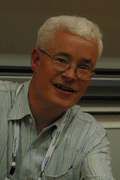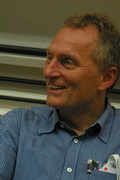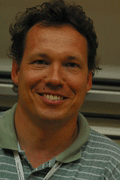"The golden age of numerical analysis has not yet started!�
October 21, 2007

Nick Trefethen
So proclaimed Volker Mehrmann, midway through the round table discussion "Future Directions in Numerical Analysis," moderated by Gene Golub and Nick Trefethen at ICIAM '07.

Volker Mehrmann
Presentations by the panel members---Tony Chan (UCLA and NSF), Martin Gander (Geneva), Mehrmann (TU Berlin), Valeria Simoncini (Bologna), and Ya-Xiang Yuan (Beijing)---sparked a lively, wide-ranging discussion among the engaged Thursday-evening audience.
Chan opened the session, provocatively declaring, "The name: Change it!" The term numerical analysis is too restrictive, failing to capture the intellectual breadth required of modern computational scientists, he suggested. When polled by the organizers, the audience seemed to sharply disagree, while admitting that the term carries with it some baggage. As the evening progressed, the difference of opinion largely simmered down to semantics. "Numerical Analysis" remains a useful label for an established body of knowledge, but the audience's consensus was that the age in which a researcher could spend a career within the narrow confines of that body of knowledge---if it ever existed---had long passed. To move the field forward, to advance in algorithms, analysis, and modeling, we must develop our understanding in both pure mathematics (analysis, algebra, geometry, . . . ) and application areas.
Gander explored the growth of numerical analysis over the past forty years, as one might measure by impact factors and page counts for our journals. After discussing the merits of such metrics, Jim Demmel suggested a different approach: We can gauge our utility by the extent to which our algorithms and software are applied, even if eventual users are unaware of the ideas upon which they rely. This must be a real impact, he said.

Martin Gander
After introducing his remarks with the title of this piece, Mehrmann elaborated. Contemporary problems incorporate more sophisticated physical models, and even these are typically only objective functions for a design optimization that is the true goal of the computation. "Models from engineering and science get more and more extreme, but current methods are completely inadequate for these models," he said. Favoring the German label Numerische Mathematik, Mehrmann emphasized that the future of the discipline "can only go well if there is more mathematics in numerical mathematics."
Following this thread, former SIAM president Mac Hyman emphasized the increasing role that quantifying uncertainty now plays in computational science. No longer is it sufficient to compute a "best guess" to a solution; the result must now be qualified: "How confident are you in that best guess?" In coming years, we will see growing use of discrete models, networks, Monte Carlo simulation, and databases. Golub promoted the idea of the "mathematical sciences" as a whole, with a relaxation of the borders that separate our field from statistics and operations research.
In addition to changes in mathematical tools and applications, Demmel and Hyman emphasized that numerical analysts must anticipate the significant changes in computer architecture on the horizon, and be ready with appropriate algorithms to match. Eugene Tyrtyshnikov was more emphatic: Real changes come from algorithms, rather than faster processors.
With the audience proposing a growing litany of skills that numerical analysts should master, Trefethen wondered, "Where do we get students, and how do we teach them so many fields?" What essential tools should be included in the modern numerical analyst's toolbox?
To begin, we must organize the pre-existing curriculum effectively. Golub exhorted the audience to teach courses in matrix analysis, rather than linear algebra ("How many educated mathematicians do not know the singular value decomposition?"), then wondered whether numerical analysis should be taught as a standard elementary course, like calculus.
Demmel questioned the way we teach our field to students working in diverse application disciplines. As an alternative to monolithic numerical analysis classes, perhaps we might offer targeted, well-taught short courses as a means to bring specific methods to practitioners. Many audience members felt that it would be useful to have another forum for discussion of curricular issues in numerical analysis.
How might we attract new students to the field? Simoncini, drawing on her experiences in Italy, observed that undergraduates are often lured away by the perception that other branches of mathematics enjoy greater sophistication. Too often, perhaps, we underwhelm students with first-order approximations to derivatives, with Euler's method and Simpson's rule, thus training scientists who fail to appreciate the elegance and remarkable accuracy that typify our best solutions to well-behaved problems. Several audience members pointed out that some of our students first encounter numerical methods through a particular application, only to get hooked by computational questions. "The future of numerical analysis will be determined by future students," Ya-xiang Yuan emphasized. "We need good students!"
Anne Greenbaum described the enthusiasm with which undergraduates approach the international Mathematical Contest in Modeling, held each February, and asked whether the time might be right for a similar competition based more specifically on numerical computation.
Yuan directed the conversation toward the funding of mathematical research, and the inevitable skewing of specialization by those who control the purse strings. In some environments the distribution of funds might favor research in pure mathematics over numerical analysis; in others, the result could be a bias toward partial differential equations over other areas of computational mathematics.
Trefethen took a quick straw poll on audience comfort with various software tools for scientific computing. After nearly universal fluency with MATLAB, the percentages shrank steadily as Trefethen worked through a variety of symbolic computing packages, and then traditional programming languages. One can imagine how different the response might have been twenty years ago. Is this progress or regression? Should the outcome be reflected in our scientific computing classes?
In the last few minutes, the conversation turned again to the many applications that are ripe for numerical progress, ranging from biology to data mining. The future of numerical analysis? Simoncini summed it up well: "We have much to do!"---Mark Embree, Rice University, and Taketomo Mitsui, Nagoya University.

